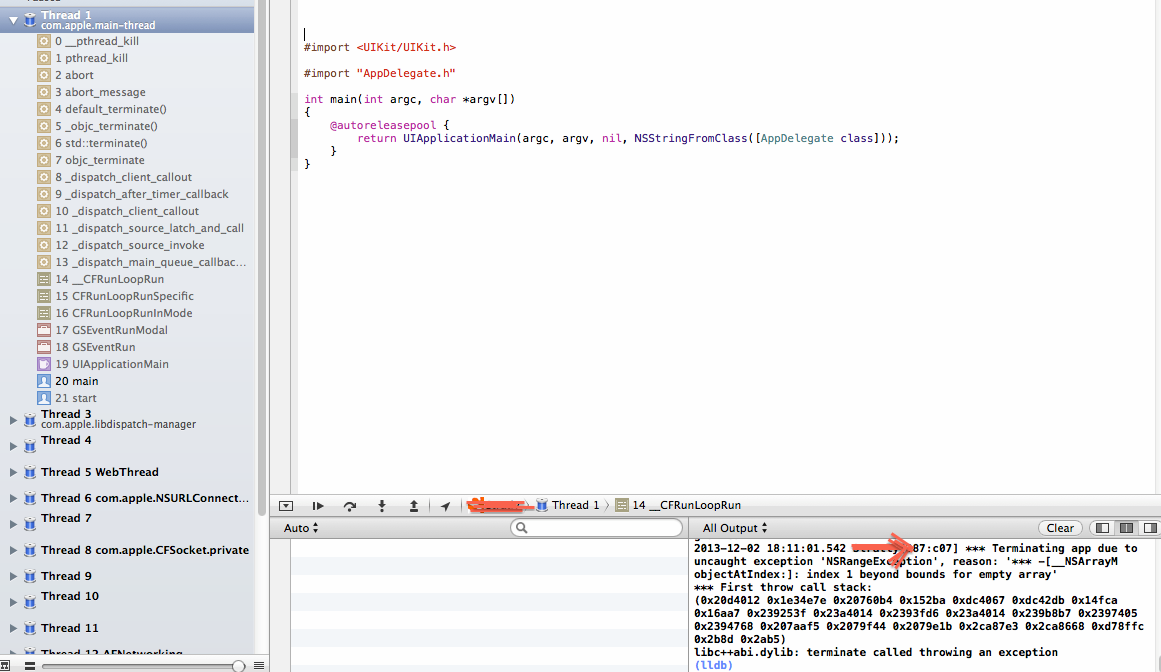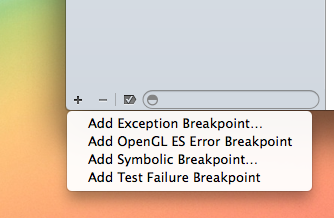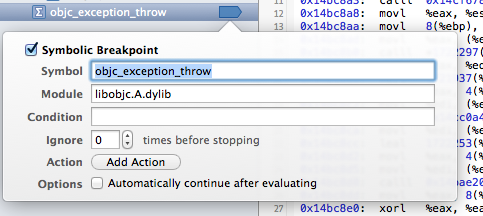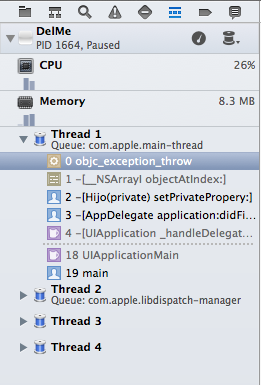我的应用程序在不同的地方崩溃,但错误与下面相同,只是索引有时会发生变化,知道为什么会发生这种情况,我也附上了我的屏幕截图:
*** Terminating app due to uncaught exception 'NSRangeException', reason: '*** -[__NSArrayM objectAtIndex:]: index 1 beyond bounds for empty array'
*** First throw call stack:
(0x20d4012 0x1e34e7e 0x20760b4 0x152ba 0xdc4067 0xdc42db 0x14fca 0x16aa7 0x239253f 0x23a4014 0x2393fd6 0x23a4014 0x239b8b7 0x2397405 0x2394768 0x207aaf5 0x2079f44 0x2079e1b 0x2ca87e3 0x2ca8668 0xd78ffc 0x2b8d 0x2ab5)
libc++abi.dylib: terminate called throwing an exception
(lldb)
我尝试调试它以查明导致崩溃的确切位置或代码行,但没有成功。它只是随机崩溃
谢谢 
编辑 1:
好的,这是代码:
获取后,我将它们保存为:
-(void)saveTweetsArray:(NSMutableArray *)array{
NSString *dbPath = [DatabaseHelper databasePath];
sqlite3_stmt *statement;
if(sqlite3_open([dbPath UTF8String], &db) == SQLITE_OK) {
NSString *insertSql = [NSString stringWithFormat:@"delete from %@ where ACCOUNTID='%@'",[DatabaseHelper TweetsTable],self.accountId];
const char *insertStmt = [insertSql UTF8String];
sqlite3_prepare_v2(db, insertStmt, -1, &statement, NULL);
if(sqlite3_step(statement) == SQLITE_DONE){
NSLog(@"old tweets removed");
}
else{
NSLog(@" deletion failed");
NSLog(@"%@", [NSString stringWithUTF8String:(char*)sqlite3_errmsg(db)]);
}
sqlite3_finalize(statement);
for(int i=0;i<[array count];i++){
NSMutableDictionary *dictionary = [array objectAtIndex:i];
NSString *insertSql = [NSString stringWithFormat:@"insert into %@ (ID,TWEET_TEXT,USER_NAME,ACCOUNTID) values (?,?,?,?)",[DatabaseHelper TweetsTable]];
const char *insertStmt = [insertSql UTF8String];
sqlite3_prepare_v2(db, insertStmt, -1, &statement, NULL);
sqlite3_bind_text(statement, 1, [[dictionary valueForKey:@"id"] UTF8String], -1, NULL);
sqlite3_bind_text(statement, 2, [[dictionary valueForKey:@"text"] UTF8String], -1, NULL);
sqlite3_bind_text(statement, 3, [[dictionary valueForKey:@"userName"] UTF8String], -1, NULL);
sqlite3_bind_text(statement, 4, [self.accountId UTF8String], -1, NULL);
if(sqlite3_step(statement) == SQLITE_DONE)
NSLog(@"data saved");
else{
NSLog(@"save failed");
NSLog(@"%@", [NSString stringWithUTF8String:(char*)sqlite3_errmsg(db)]);
}
sqlite3_finalize(statement);
}
sqlite3_close(db);
}
这是我在获取新推文时获取并填充到表格 View 的位置:
-(NSMutableArray*)tweetsArray{
NSMutableArray* tweetsArray=[[NSMutableArray alloc] init];
NSString *dbPath = [DatabaseHelper databasePath];
if(sqlite3_open([dbPath UTF8String], &db) == SQLITE_OK) {
const NSString *sql_stmt;
sql_stmt= [NSString stringWithFormat:@"select ID,TWEET_TEXT,USER_NAME from %@ where ACCOUNTID='%@' ",[DatabaseHelper TweetsTable],self.accountId];
const char *sql_stmt1=[sql_stmt UTF8String];
sqlite3_stmt *compiledStatement;
if(sqlite3_prepare_v2(db, sql_stmt1, -1, &compiledStatement, NULL) == SQLITE_OK) {
// Loop through the results and add them to the feeds array
while(sqlite3_step(compiledStatement) == SQLITE_ROW) {
// Read the data from the result row
NSMutableDictionary *dictionary=[[NSMutableDictionary alloc] init];
[dictionary setValue:[NSString stringWithUTF8String:(char *)sqlite3_column_text(compiledStatement, 0)] forKey:@"id"];
[dictionary setValue:((char *)sqlite3_column_text(compiledStatement, 1))!=NULL?[NSString stringWithUTF8String:(char *)sqlite3_column_text(compiledStatement, 1)]:@"" forKey:@"text"];
[dictionary setValue:[NSString stringWithUTF8String:(char *)sqlite3_column_text(compiledStatement, 2)] forKey:@"userName"];
[textsArray addObject:dictionary];
}
sqlite3_finalize(compiledStatement);
}
}
sqlite3_close(db);
return textsArray;
}
这是我在格式化后放在 tableview 上的地方:
-(void)formatTweetsAndPaintView{
NSArray *tweets = [dictionary valueForKey:@"twitter"];
//first save the old tweets to show while new are fetched
NSMutableArray *tempTweets=[[NSMutableArray alloc] initWithArray:[baseController tweetsArray]];
//then clear the old tweets then format and fill array
[[baseController tweetsArray] removeAllObjects];
if(tweets && tweets.count){
for(int i=0;i<[tweets count];i++){
NSMutableDictionary *tweetsDictionary = [[NSMutableDictionary alloc] init];
[tweetsDictionary setValue:[[tweets objectAtIndex:i] valueForKey:@"id_str"] forKey:@"id"];
[tweetsDictionary setValue:[[tweets objectAtIndex:i] valueForKey:@"text"] forKey:@"text"];
[tweetsDictionary setValue:[[[tweets objectAtIndex:i] valueForKey:@"user"] valueForKey:@"name"] forKey:@"userName"];
[[baseController tweetsArray] addObject:tweetsDictionary];
}
}
//include non duplicate tempTweet to tweetArray
for(int i=0;i<[tempTweets count];i++){
if(![[baseController tweetsArray] containsObject:[tempTweets objectAtIndex:i]])
[[baseController tweetsArray] addObject:[tempTweets objectAtIndex:i]];
}
if([dictionary valueForKey:@"twitter"])
[baseController setDictionary:[dictionary valueForKey:@"twitter"]];
[baseController reloadTableViewData];
//finally save the tweets
[[TweetDB _instance] saveTweetsArray:[baseController tweetsArray]];
}
最佳答案
如果你想在程序崩溃的地方停止你的程序,你需要添加一个异常断点。
转到 Breakpoint Navigator,单击加号按钮,然后选择 Add Exception Breakpoint...

在 XCode 5 中它会直接添加它,但在以前的版本中你需要选择:所有异常(exception)
这将在您的 NSArray 被越界访问的地方停止,然后您可以进行调试。
编辑:
程序停止后,您应该能够在 XCode 中看到它崩溃的那一行。如果您在 XCode 中没有看到该行,您可以在调试器中输入:
(lldb) BT
'bt' 将打印程序为到达那里所做的所有步骤,它会为您提供有关调用了哪些方法的信息。
如果这不能为您提供所需的信息,您可以尝试以下方式:
您的第二个选择是重复之前的步骤,但不要选择添加异常断点...您应该选择广告符号断点...
选择它后,将弹出一个窗口提示输入一些值。输入以下内容:

在崩溃之前它应该停止。此时您可以导航到 Debug Navigator 以查看步骤是什么,并找出位置:

如您所见,setPrivateProperty 是停止前最后一次调用方法。
如果 Debug Navigator 没有给您任何信息,您可以随时转到调试器并键入:
(lldb) BT
和以前一样,'bt' 将追溯所有步骤以更详细地到达目的地。
所有这些信息应该足以调试您的程序。如果您需要帮助来解释“bt”输出,那是另一个话题!
关于ios - 应用程序崩溃 : Index out of bound at random places,我们在Stack Overflow上找到一个类似的问题: https://stackoverflow.com/questions/20329061/